Black and white coloration is visually striking. A deep contrast in colors can draw the eye and make birds and other animals stand out. But sometimes, it helps them blend in. Birds can be black and white for several reasons, including camouflage and confusion. In other words, it helps them catch prey or escape predation. Check out these 26 black and white birds and discover where they live, what they eat, and how to identify them.
1. Common Loon

Common loons breed on freshwater lakes and winter along the coast.
©Rejean Bedard/Shutterstock.com
Identification: These birds are large, diving waterfowl that appear duck-like but belong to a different family. They feature all-black rounded heads and long black-and-white spotted bodies. Their bills are long and straight, and they have short tails.
Habitat and Location: They live throughout Canada and the United States, where they breed on freshwater lakes and winter along the coast. But you can also find them in rivers and estuaries.
Diet: They eat fish, crayfish, shrimp, and aquatic vegetation.
Nests: They nest in mounds of dead grass near the water’s edge.
2. Black-Capped Chickadee
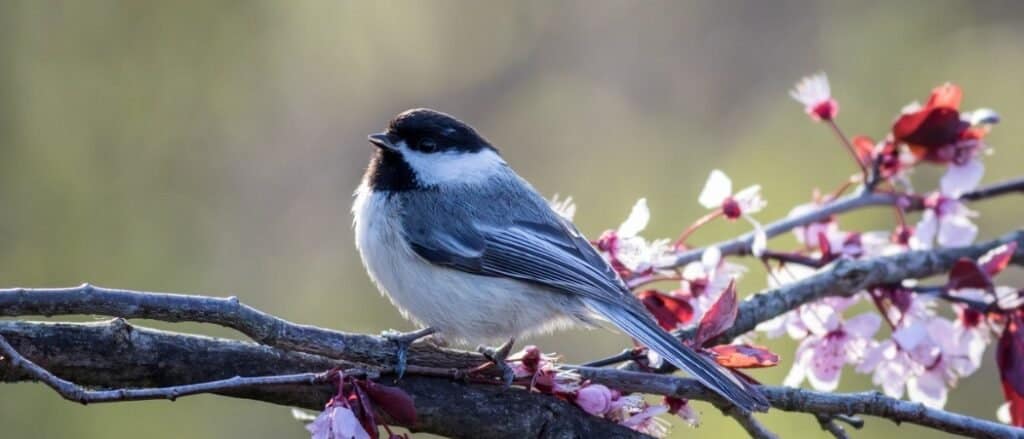
The black-capped
chickadee
lives in various wooded and forested areas.
©Rabbitti/Shutterstock.com
Identification: Black-capped chickadees are tiny and round with a long tail and a short beak. Their heads and throat are black, and their cheeks and the side of their heads are white. They have streaky grayish-blue backs and whitish undersides.
Habitat and Location: These birds live in many wooded and forested areas, including woodlots, forests, parks, backyards, and fields. They live year-round in the Northern United States and most of Canada.
Diet: They consume insects, spiders, snails, caterpillars, berries, seeds, and small fruits.
Nests: They rest in cup-shaped moss nests placed in a tree cavity.
3. Black and White Warbler
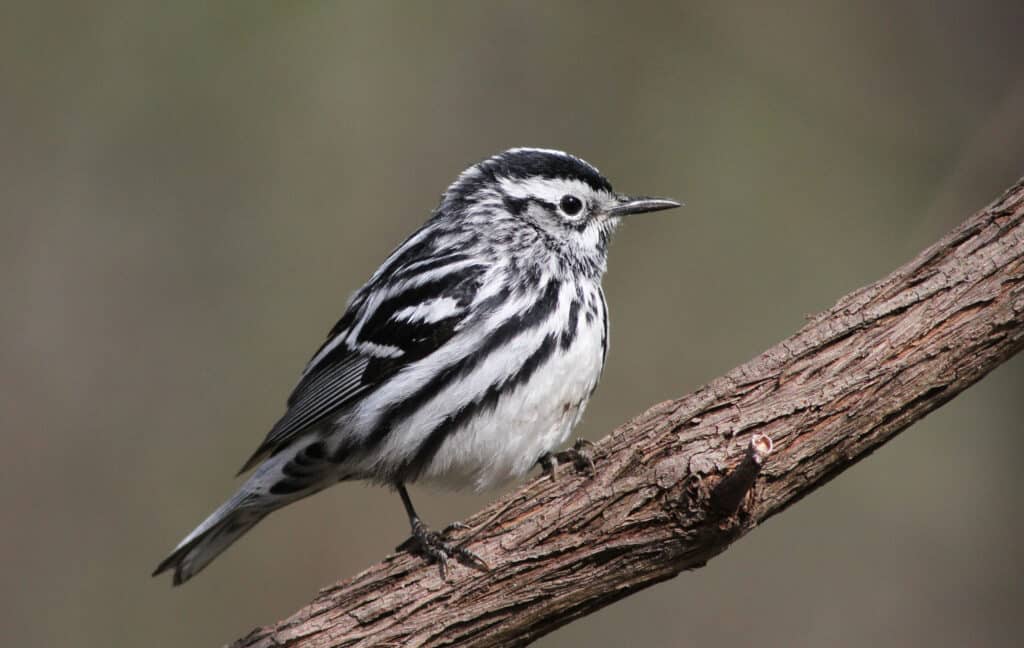
These birds have bold black and white stripes with black wings and white bars. The male’s stripes are crisper than the female’s.
©Mircea Costina/Shutterstock.com
Identification: These small songbirds are quintessential black and white birds. They are white with heavy black stripes all over their body. They feature long wings, long bills, and short tails.
Habitat and Location: They live in deciduous and mixed forests in Eastern Canada, the United States, Mexico, Central America, and Northern South America.
Diet: Moth and butterfly larvae, ants, spiders, beetles, and flies are their favorites.
Nests: They lay eggs in open leaf cups hidden at the base of a tree, log, or bush.
4. Carolina Chickadee
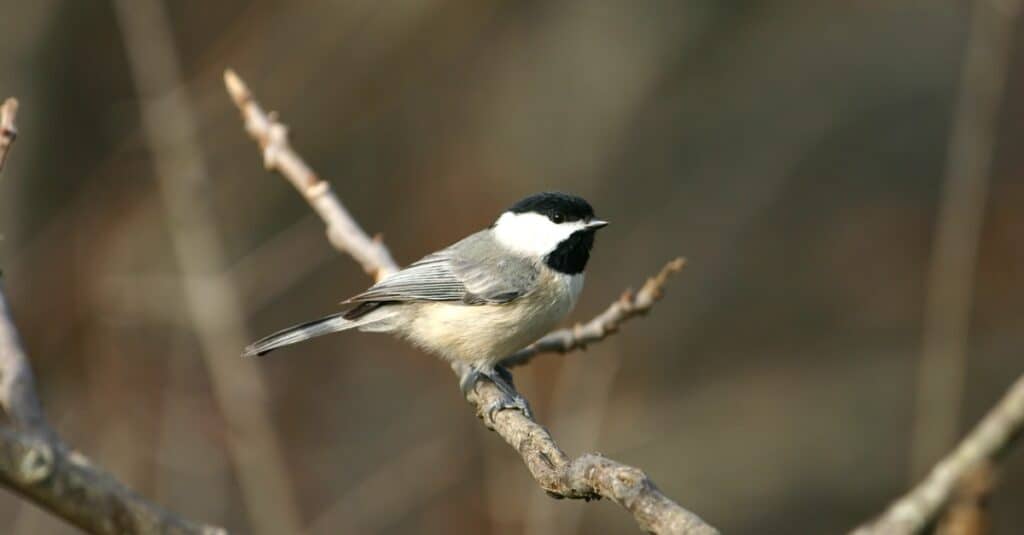
The Carolina chickadee averages around 5 inches in length.
©iStock.com/lgunderson
Identification: This chickadee is tiny and round, with a short neck, a long tail, and a relatively large head. They look very similar to the black-capped chickadee, featuring a black and white head and streaky gray bodies.
Habitat and Location: The Carolina chickadee lives in forested areas, parks, suburban backyards, and urban areas. They live permanently in the Southeastern United States.
Diet: They snack on insects, spiders, seeds, and vegetation.
Nests: They’ll use tree cavities or a nest box.
5. Lark Bunting

Lark buntings have heavy conical bills and white wing patches.
©iStock.com/Nancy Strohm
Identification: Adult breeding males are black with white wing patches. They are large sparrows with heavy conical bills and round bodies. Outside of the breeding season, males appear streaky brown like females.
Habitat and Location: Lark buntings live in open grasslands and agricultural fields in the Central United States and Mexico.
Diet: To survive, they eat grass seeds, cactus fruit, spiders, grains, and insects.
Nests: They build loose grass cups at the base of cacti or shrubs.
6. Black Phoebe

Black Phoebe birds mainly eat insects that they catch in the air.
©iStock.com/G Parekh
Identification: The black Phoebe is a small, round flycatcher with a black head, dark gray upper parts, and white underparts. They have relatively large heads, medium-length tails, and straight bills.
Habitat and Location: They live near rivers, streams, lakes, and the ocean. You can find them along the Pacific coast in the United States, Mexico, Central America, and South America.
Diet: They’ll eat flies, wasps, beetles, bees, spiders, termites, and grasshoppers.
Nests: A mud cup lined with vegetation in rock faces, boulders, and tree hollows is used as a nesting site.
7. Blackpoll Warbler
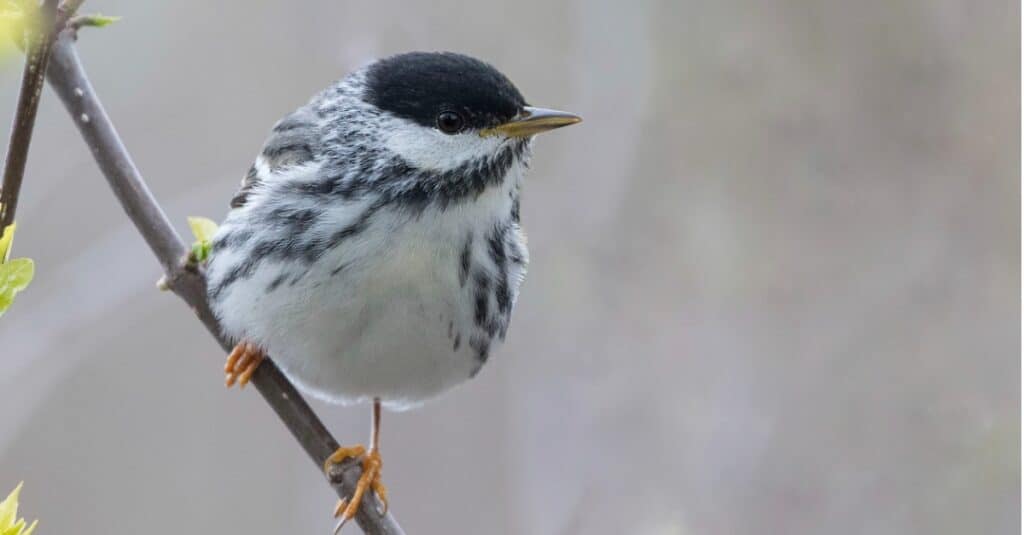
The male blackpoll warbler has wings with black and white stripes.
©iStock.com/Cam-Image
Identification: The blackpoll is a long-winged warbler with a short tail and a small bill. Breeding males are streaky black and white with all-black caps.
Habitat and Location: They inhabit boreal, evergreen, and deciduous forests. And they breed in Canada before migrating to South America for the winter. You can spot them in the Eastern United States during migration.
Diet: They frequently consume spiders, caterpillars, ants, beetles, lice, honeysuckle, and pokeberry.
Nests: They construct a twig cup near the tree trunk of a spruce or fir.
8. Black-Billed Magpie
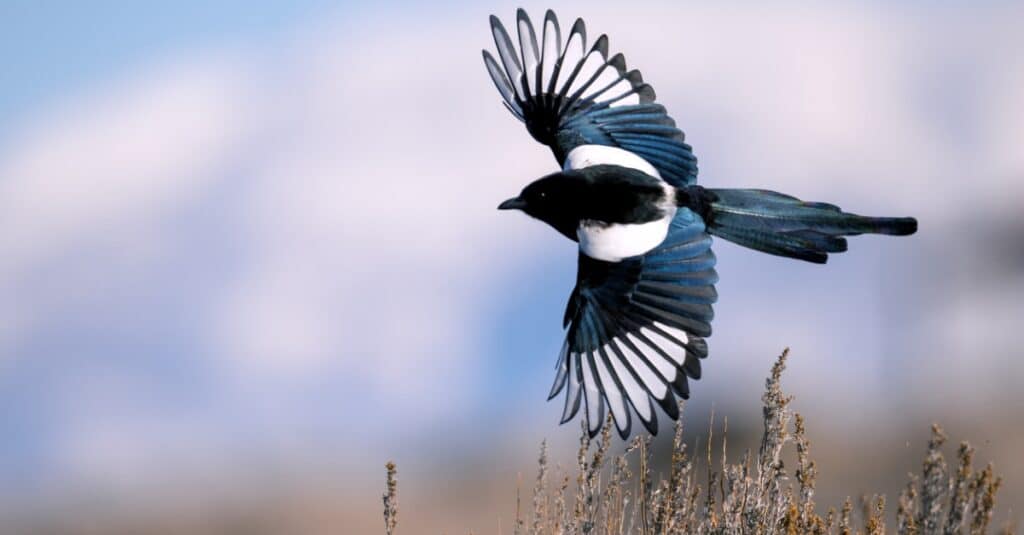
Magpies often form friendships with people.
©iStock.com/kojihirano
Identification: The black-billed magpie is a stunning bird featuring black and white bodies and bluish-green iridescent wings and tails. They are relatively large birds (belonging to the corvid family) with very long tails and heavy bills.
Habitat and Location: These birds are common in towns and fields year-round in the Northwestern section of the United States and Southwestern Canada.
Diet: Fruit, grain, beetles, grasshoppers, small mammals, baby birds, and carrion are their favorite foods.
Nests: Their nests are stick and mud domes placed in trees, shrubs, buildings, or utility poles.
9. Rose-Breasted Grosbeak
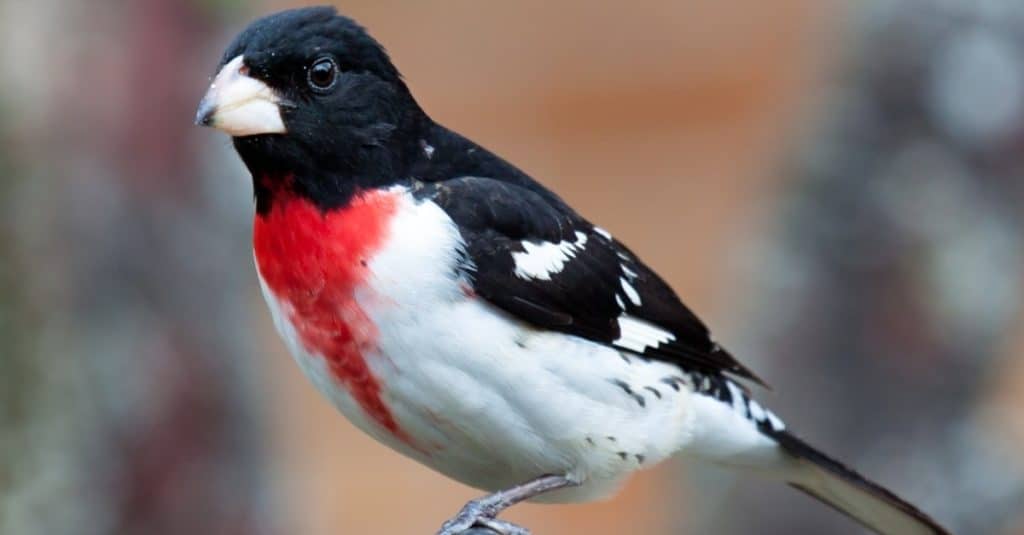
The rose-breasted grosbeak is a robust songbird with a thick conical bill.
©Mike Truchon/Shutterstock.com
Identification: Rose-breasted grosbeaks are medium and robust songbirds with thick conical bills and squared tails. Adult males are black and white with distinctive red breasts.
Habitat and Location: They live around deciduous and coniferous forest edges and parks in the Eastern United States and Canada before migrating to Central and South America for the winter.
Diet: Their diet is made up of beetles, ants, flies, moths, butterflies, berries, buds, flowers, grains, and seeds.
Nests: Loose stick cups set in a tree fork are makeshift nests.
10. American Oystercatcher
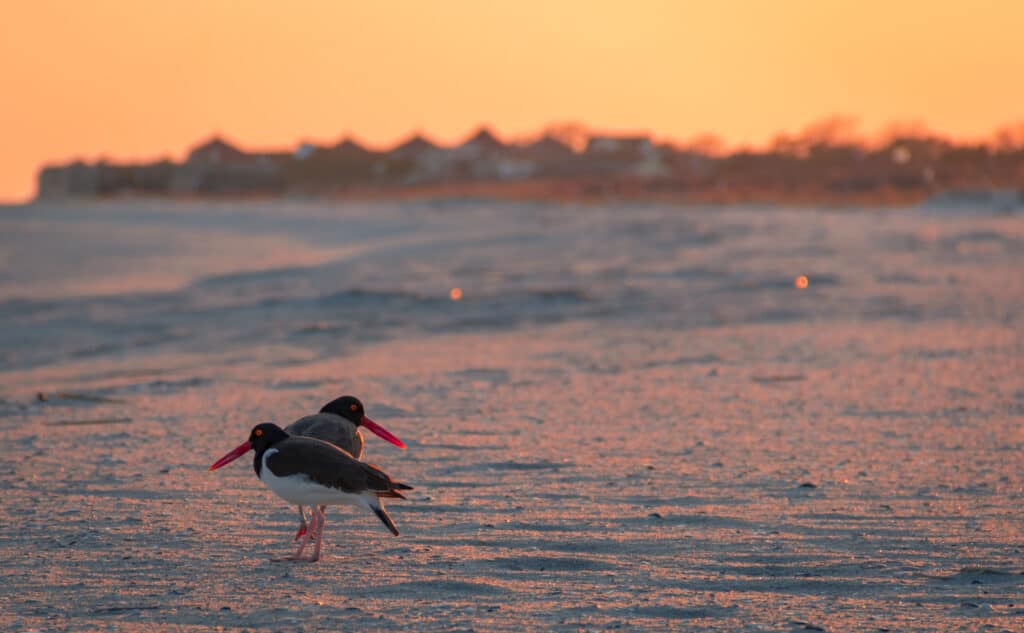
American oystercatchers are large shorebirds with black heads and white undersides.
©iStock.com/Rabbitti
Identification: The American oystercatcher is a large shorebird with a black head, brown upper sides, and white undersides. They have a long orange bill, long legs, and a thick neck. And adults have bright yellow eyes.
Habitat and Location: The oystercatcher inhabits beaches, reefs, saltwater marshes, and islands. They live year-round along the coasts in the Southeastern United States, Mexico, Central America, and South America.
Diet: Mollusks, clams, oysters, mussels, and other marine creatures make up the bulk of their diet.
Nests: They nest in sand scrapes on barrier beaches behind dunes.
11. Black-Necked Stilt
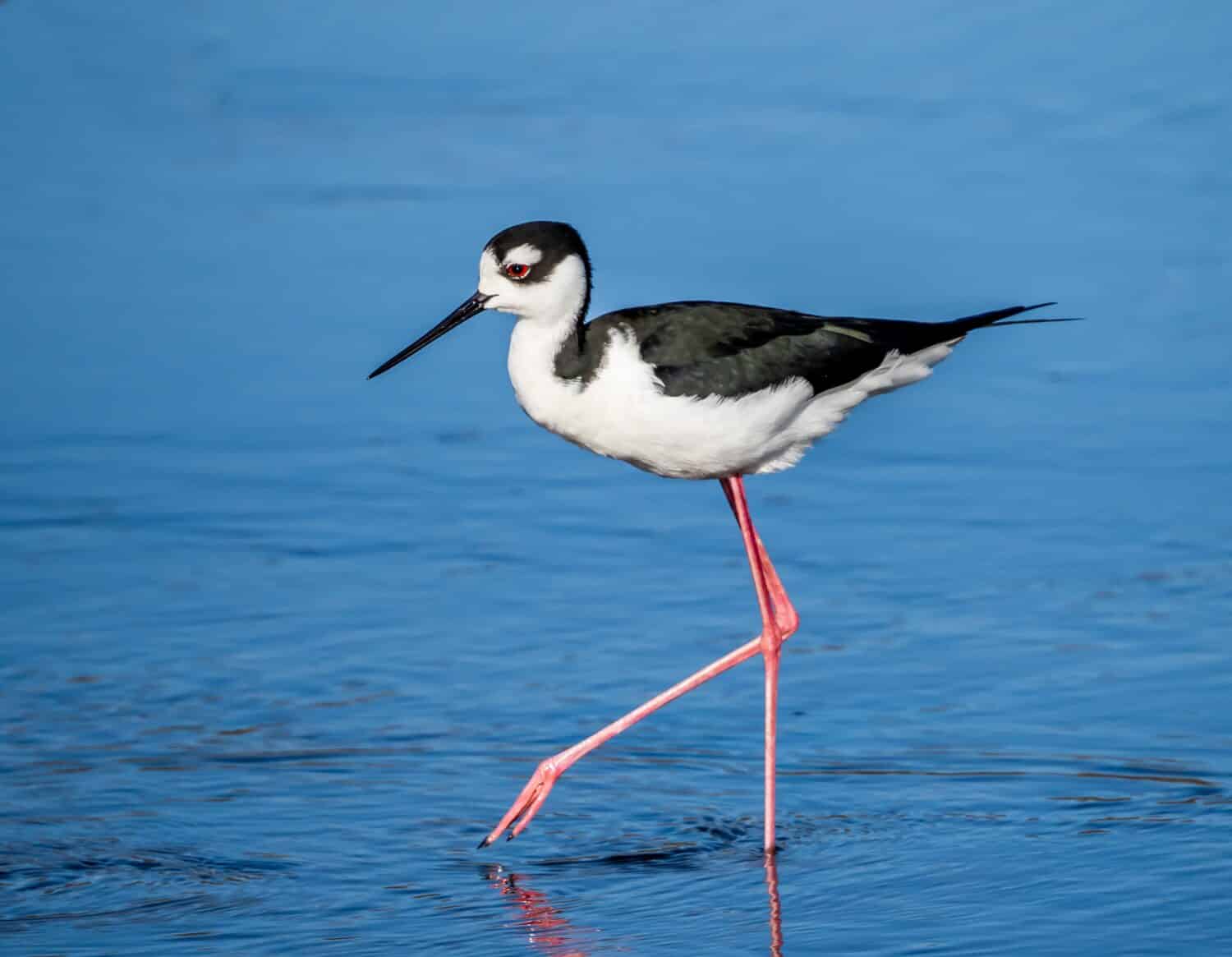
The black-necked stilt has a black and white body with long pink legs.
©Jim Schwabel/Shutterstock.com
Identification: The black-necked stilt is a tall yet small shorebird with long legs, a long bill, and a long neck. Their bodies are black above and white below. And they have light pink legs.
Habitat and Location: They live in shallow water, such as saltwater marshes, ponds, flooded fields, and mudflats. They breed in scattered locations in the US but reside permanently in Mexico and South America.
Diet: Aquatic insects, crustaceans, small fish, amphibians, and snails keep these birds going.
Nests: They form depressions in the dirt on small islands.
12. White Wagtail
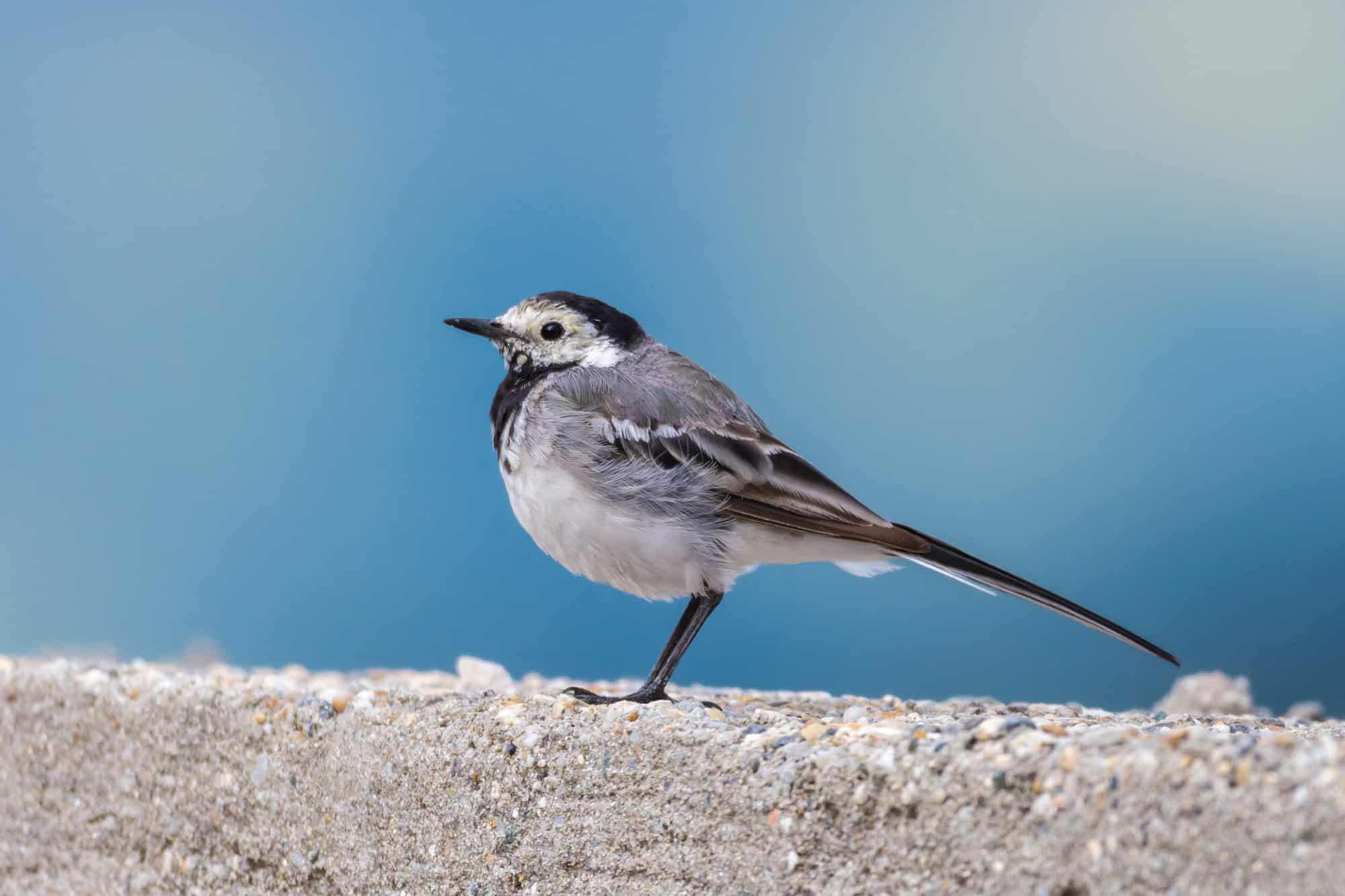
The white wagtail lives in many habitats, including grasslands, shorelines, and parks.
©iStock.com/ConstantinCornel
Identification: White wagtails are small, slender passerines with characteristically long, wagging tails. Adults have black heads with white face masks. And their bodies are bluish-gray above and white below.
Habitat and Location: They inhabit many environments, including grasslands, shorelines, farmland, parks, and towns. This species lives across Europe, Asia, and parts of Northern Africa.
Diet: They prefer beetles, snails, spiders, worms, crustaceans, maggots, and small fish.
Nests: They use crevices in stone walls and other structures.
13. Pied Avocet

The pied avocet’s beak is thin with an upward curve.
©iStock.com/Ian Fox
Identification: The pied avocet is a tall, slender, and small-bodied wading bird. They have white plumage with black caps and black wing patches.
Habitat and Location: They inhabit shallow lakes and other brackish wetlands in Asia, Africa, and Europe.
Diet: They primarily eat aquatic insects and crustaceans.
Nests: A scrape on open ground or a vegetation mound works as a nest.
14. Black-Headed Ibis
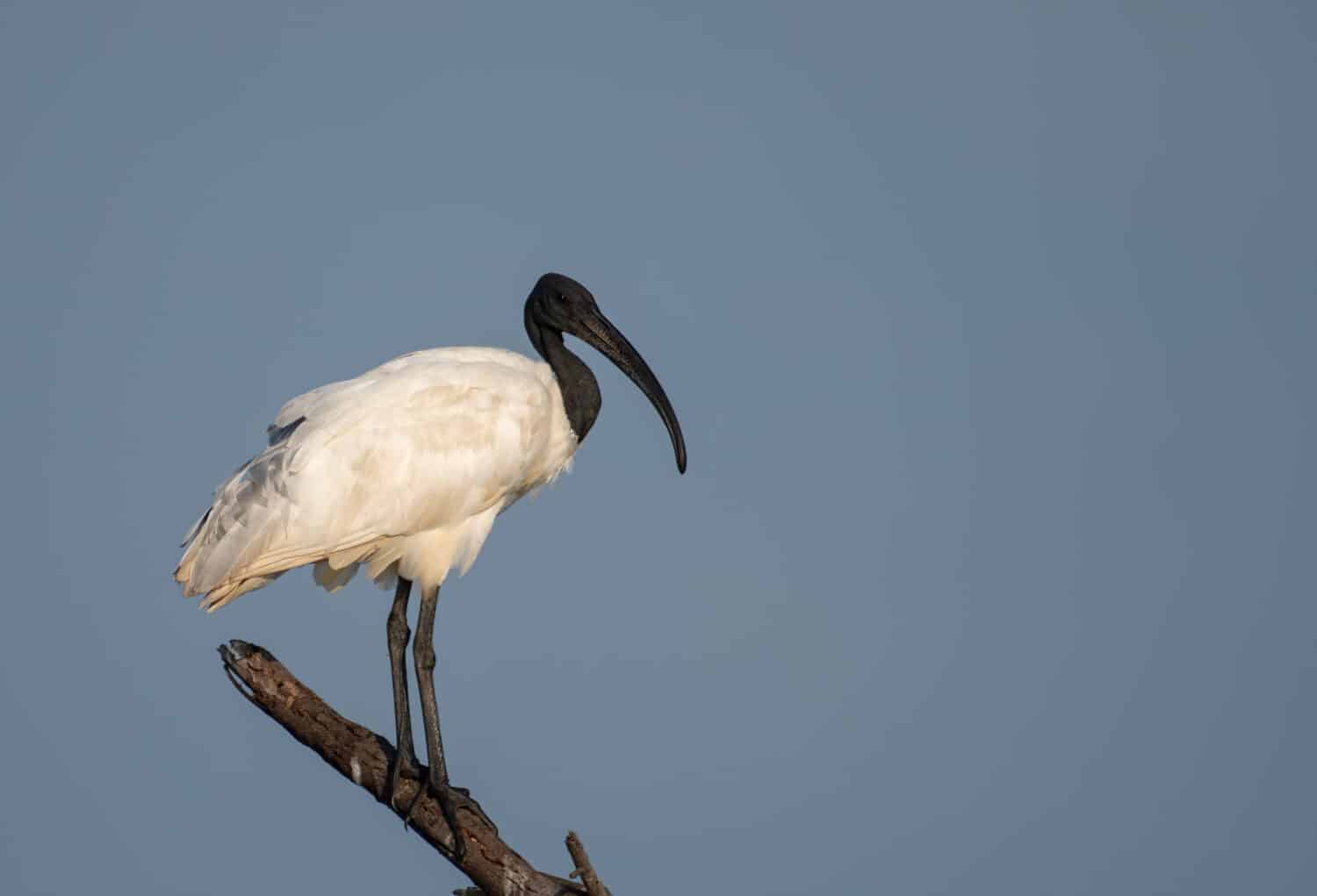
The black-headed ibis lives in saltwater and freshwater wetlands in Asia.
©mihirjoshi/Shutterstock.com
Identification: As its name suggests, the black-headed ibis has an all-black head with a white body and black legs. These wading birds have long legs, heavy bodies, long necks, and long, thick bills.
Habitat and Location: They live in freshwater and saltwater wetlands in Asia, including marshes, lakes, ponds, rice fields, and reservoirs.
Diet: Fish, aquatic insects, crustaceans, and frogs are their main food sources.
Nests: They build a stick platform near wetlands in colonies.
15. Australian Magpie
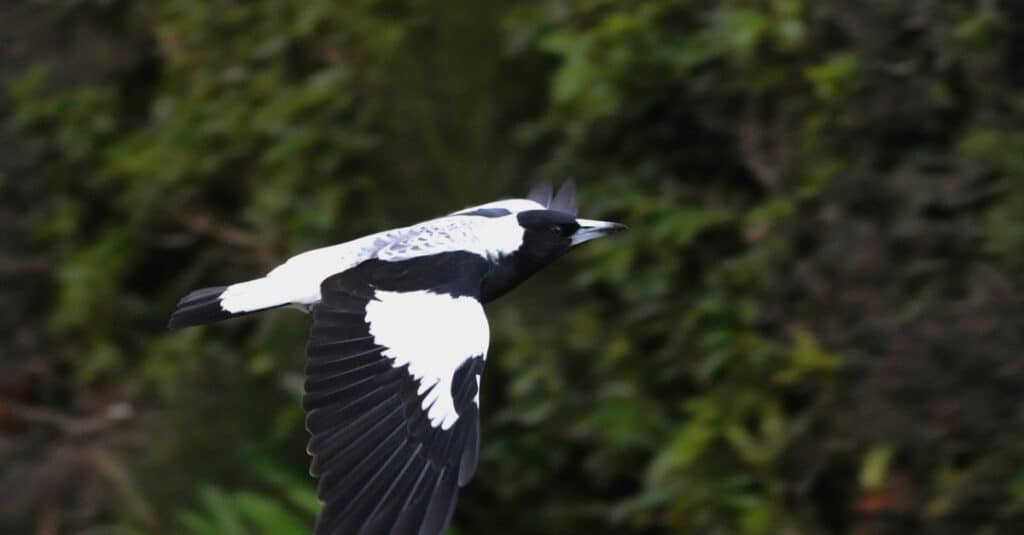
Australian magpies are native to Southern New Guinea.
©iStock.com/LKR Photography
Identification: The Australian magpie is a robust passerine, with long legs and a wed-shaped bill. Adults are mostly black with white backs and napes.
Habitat and Location: They are native to Southern New Guinea, where they inhabit grasslands, fields, parks, golf courses, and gardens.
Diet: They typically ingest worms, millipedes, spiders, scorpions, cockroaches, beetles, frogs, mice, grain, fruits, and nuts.
Nests: They form stick bowls near human habitations.
16. Yellow-Bellied Sapsucker

While sap is not the only thing yellow bellies eat, it accounts for a significant proportion of their diet.
©Dennis W. Donohue /Shutterstock.com
Identification: These small woodpeckers have long wings and broad, straight bills. They have black and white checkered bodies with bright red faces.
Habitat and Location: They inhabit hardwood and coniferous forests across the Eastern United States, Canada, Mexico, and Central America.
Diet: Sap, ants, spiders, and flying insects are their main foods.
Nests: Tree cavities are used for nesting zones.
17. Bufflehead
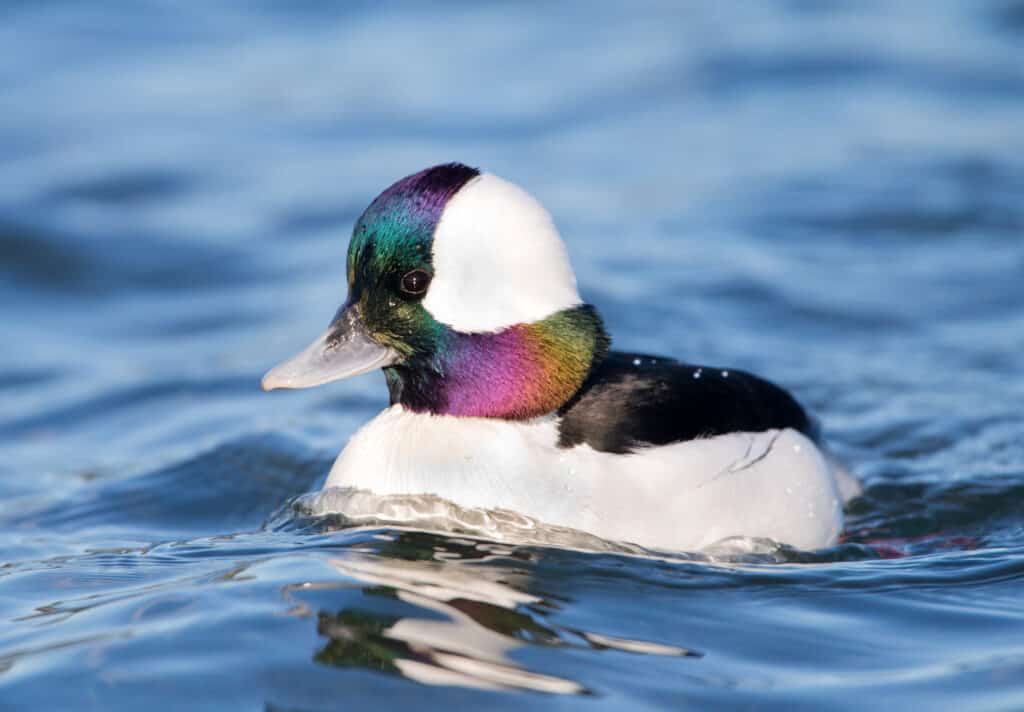
The peak of the bufflehead migration is in November. They stay near lakes and saltwater bays.
©Birdiegal/Shutterstock.com
Identification: These ducks are small and compact, with short bills and round heads. Adult males are white with black or dark brown back streaks. Their heads feature purple and green iridescent colors.
Habitat and Location: They stay near lakes and saltwater bays across most of the United States and Canada.
Diet: They love aquatic insects, mollusks, and crustaceans.
Nests: They prefer tree cavities and nest boxes.
18. Razorbill
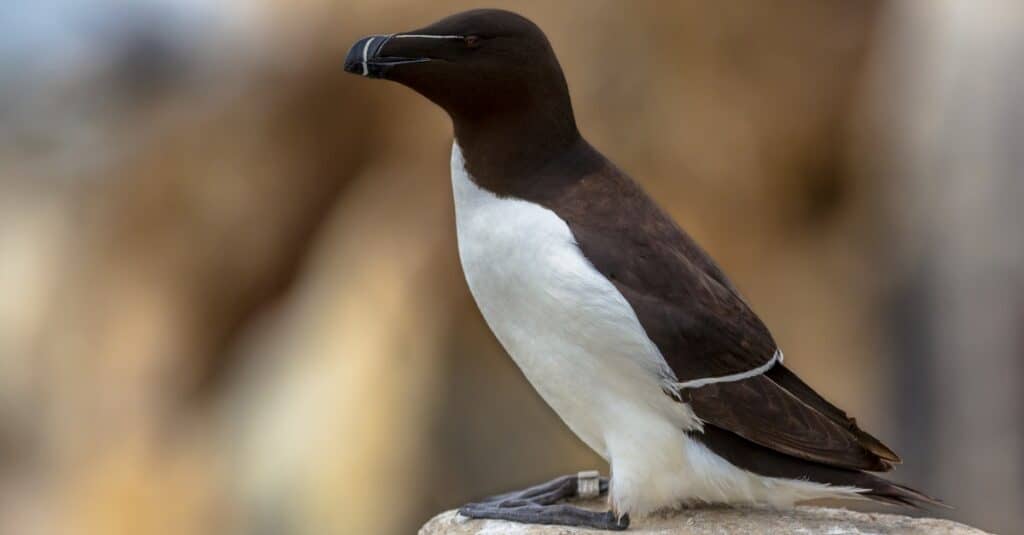
Razorbills inhabit open water and rocky cliffs in North America.
©iStock.com/CreativeNature_nl
Identification: Razorbills are robust seabirds with skinny wings, a long tail, and a broad bill. Adults are black with white undersides and fine white lines on its face and bill.
Habitat and Location: These birds inhabit rocky cliffs and islands but can mainly be found in open water near Southeastern Canada and the Northeastern United States.
Diet: Small fish, crustaceans, and bristle worms are their top choices.
Nests: Their nest may be a scrape lined with pebbles.
19. Downy Woodpecker
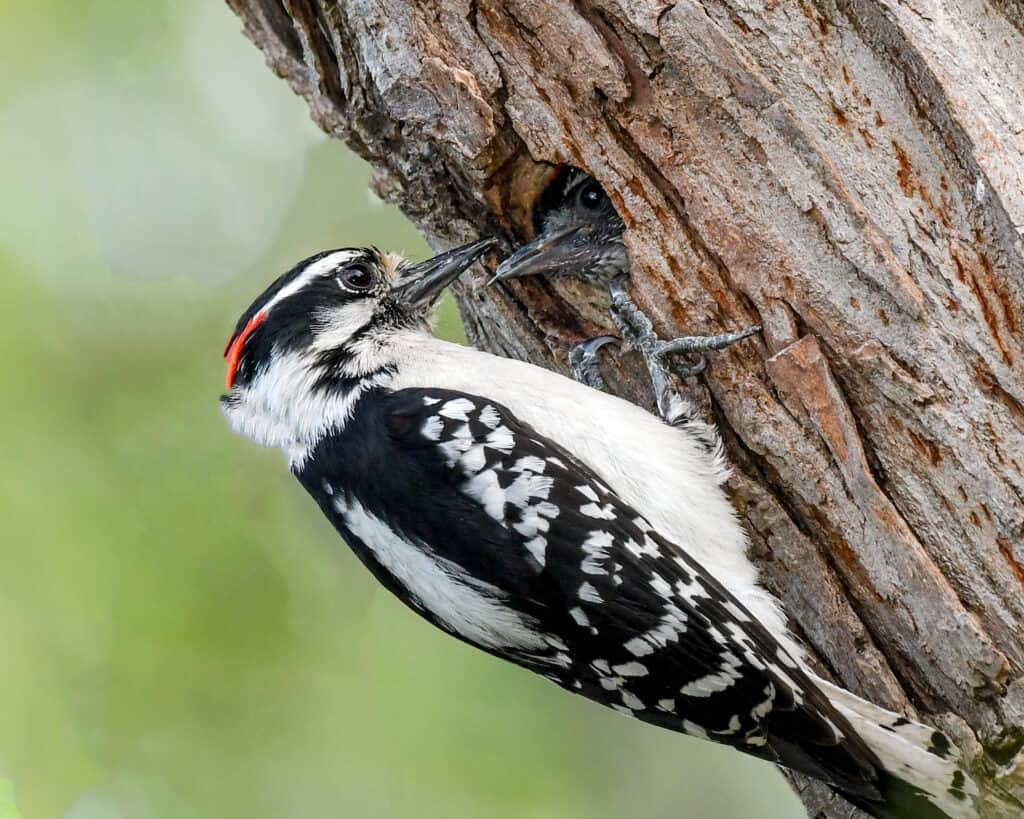
Downy woodpeckers are small with black and white checkered plumage.
©Brent Barnes/Shutterstock.com
Identification: These woodpeckers are small with broad shoulders and small, straight bills. They are black and white checkered and feature a patch of red on their heads.
Habitat and Location: They inhibit open woodlands, orchards, suburban backyards, and parks. This species live year-round in Canada and the United States.
Diet: These birds consume insects, berries, seeds, grains, and acorns.
Nests: Excavated holes in dead trees are their nests.
20. Hairy Woodpecker
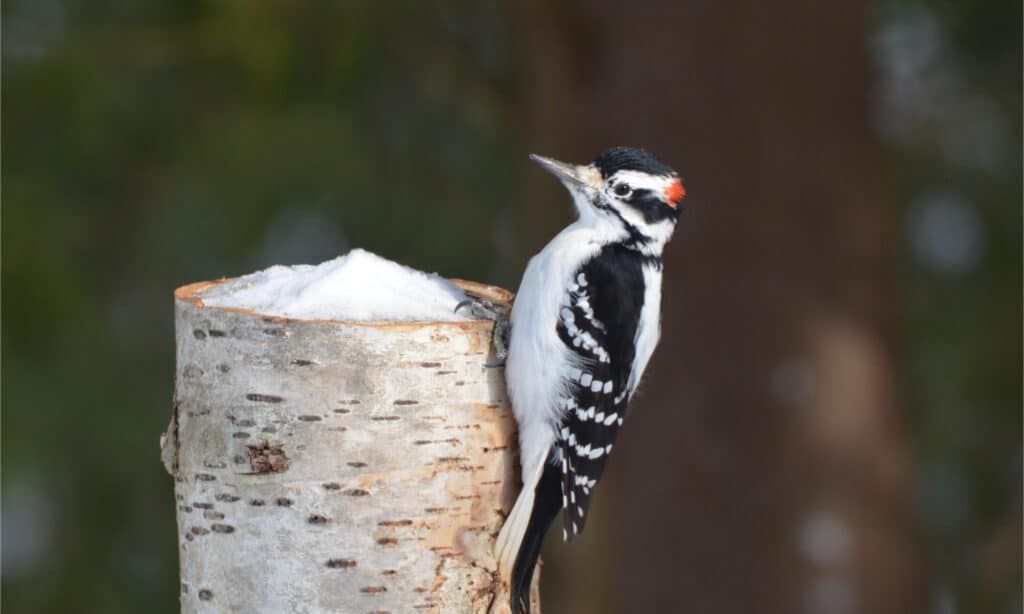
Hairy woodpeckers are slightly larger than downy woodpeckers.
©C. Hamilton/Shutterstock.com
Identification: This woodpecker is medium-sized with long tail feathers and a long bill. Their coloring is almost identical to down woodpeckers, featuring black and white checkering and a patch of red on their heads.
Habitat and Location: Hairy woodpeckers live in mature forests, backyards, and parks across most of Canada and the United States. Some also live in Mexico.
Diet: They like to eat beetle larvae, ants, moth pupae, fruits, and seeds
Nests: Dead tree cavities are turned into nests.
21. White-Breasted Nuthatch

White-breasted nuthatches feature grayish-blue backs, white undersides, white faces, and black caps.
©Jim Nelson/Shutterstock.com
Identification: The white-breasted nuthatch is a large bird with a compact body and a very short tail. They also have a long, slightly upturned bill. They feature grayish-blue backs, white undersides, white faces, and black caps.
Habitat and Location: They live in mature woodlands and coniferous forests throughout most of the United States and Mexico.
Diet: Insects, seeds, nuts, and birdfeeder products are their favorites.
Nests: They nest in tree cavities and abandoned woodpecker holes.
22. Penguins
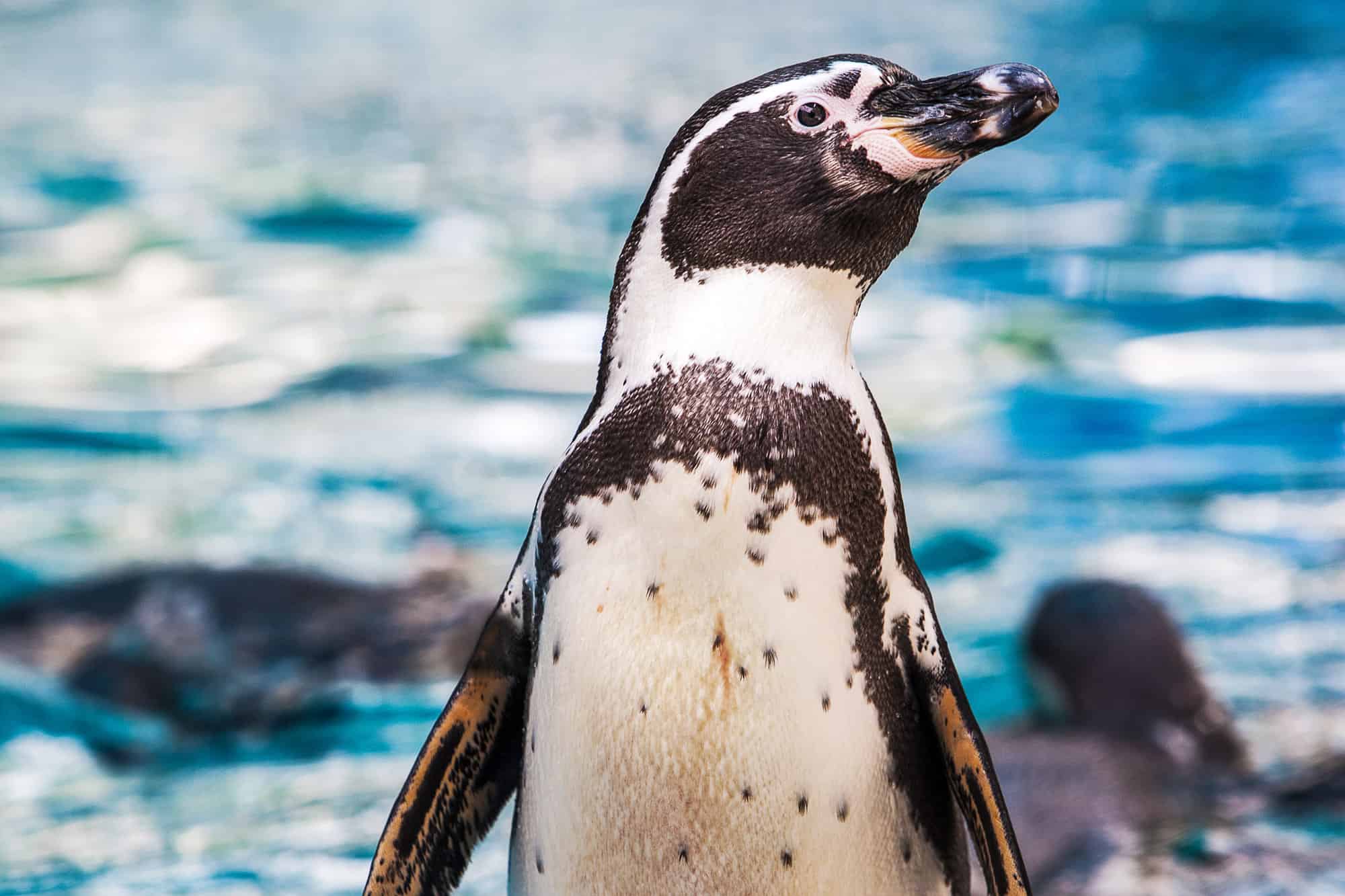
Penguins are black and white flightless birds that primarily inhabit the Southern Hemisphere.
©Smile Fight/Shutterstock.com
Identification: Penguins are a group of flightless birds with round bodies and flippers. Most feature black and white plumage, with black above and white below.
Habitat and Location: They are aquatic birds primarily inhabiting the Southern Hemisphere, where they live in oceans and along coasts.
Diet: Krill, squid, and fish make up their diet.
Nests: Scrapes in the ground, rock crevices, and underground burrows are turned into nests.
23. Black-Crowned Night Heron

The black-crowned night heron or black-capped night heron has white feathers on its breast, greyish black wings, and a black cap.
©Nycticorax nycticorax/Shutterstock.com
Identification: This small heron has a thick neck, flat head, and heavy bill. They are light gray with white undersides and a black cap.
Habitat and Location: They inhabit wetlands, such as estuaries, marshes, reservoirs, and lakes. This species has a wide distribution across North and South America.
Diet: Their food sources are aquatic insects, crustaceans, fish, amphibians, reptiles, birds, eggs, and small mammals.
Nests: A stick platform in trees or cattails is used as a nest.
24. Black and White Hawk Eagle
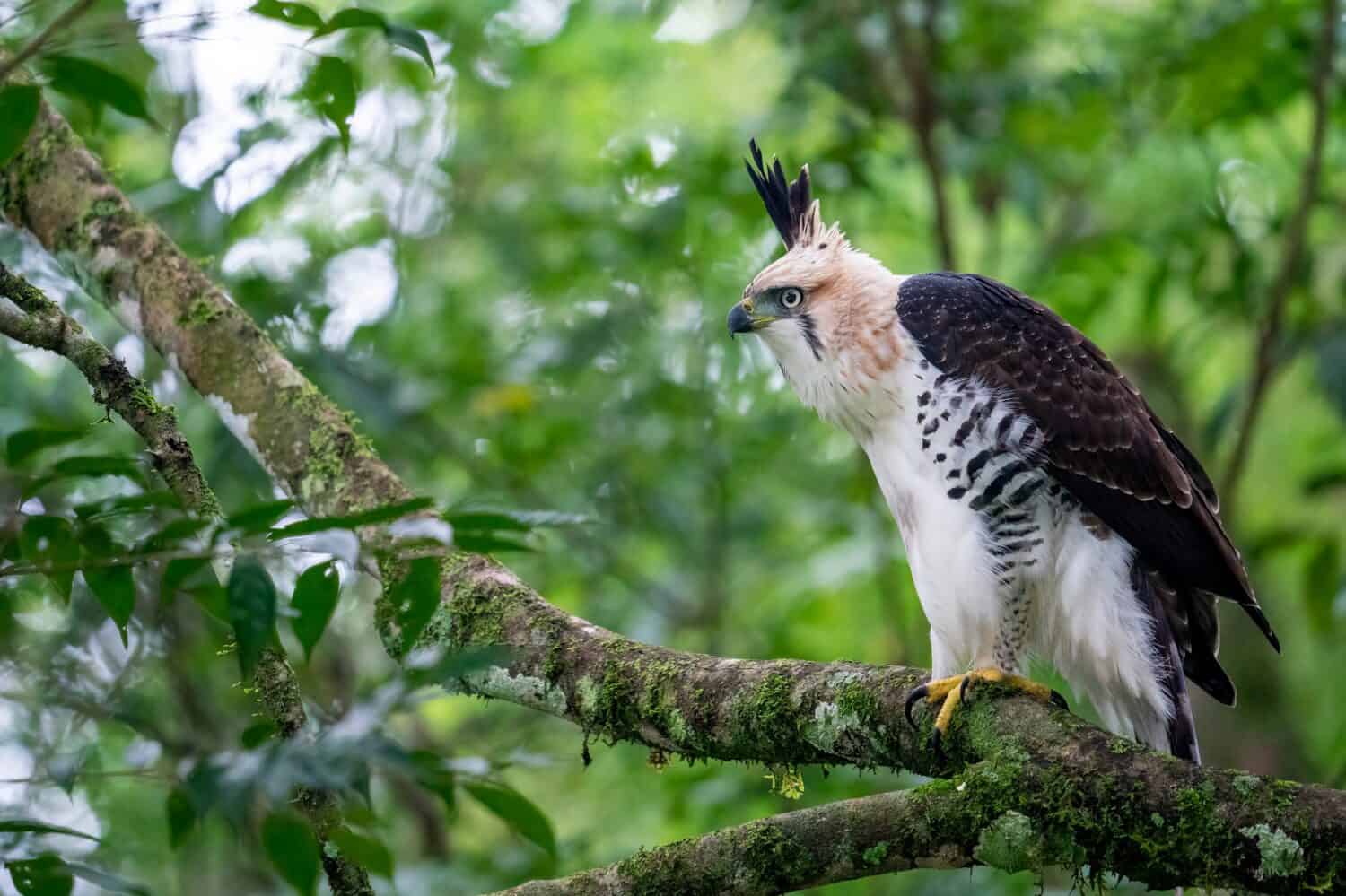
The black and white hawk eagle lives across the northern half of Africa.
©Rob Jansen/Shutterstock.com
Identification: Hawk eagles are relatively small eagles with white heads, necks, and bodies. The wings are black, and there are black rings around the bright yellow eyes.
Habitat and Location: They live in many types of lowland forests, from dense and humid to semiarid. They live across much of the northern half of Africa.
Diet: Birds, mammals, reptiles, and amphibians are all prey.
Nests: The construct stick platforms in trees.
25. Gyrfalcon
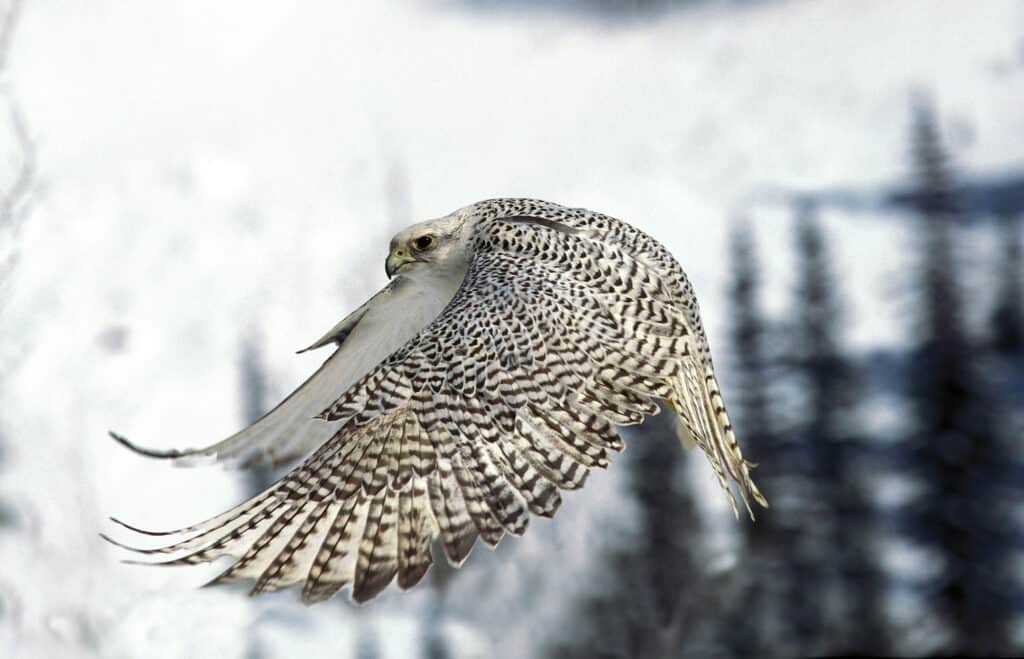
Gyrfalcons are white with gray or black banding.
©iStock.com/slowmotiongli
Identification: The gyrfalcon is the largest falcon in the world and features long, pointed wings, long tails, and a thick body. They are white with gray or black banding and spotting.
Habitat and Location: They live on Arctic tundra, open fields, prairies, and along coasts. You will find them across Canada and Greenland.
Diet: They prey on birds and small mammals.
Nests: These birds build stick or debris piles on cliffs or in trees.
26. American Coot
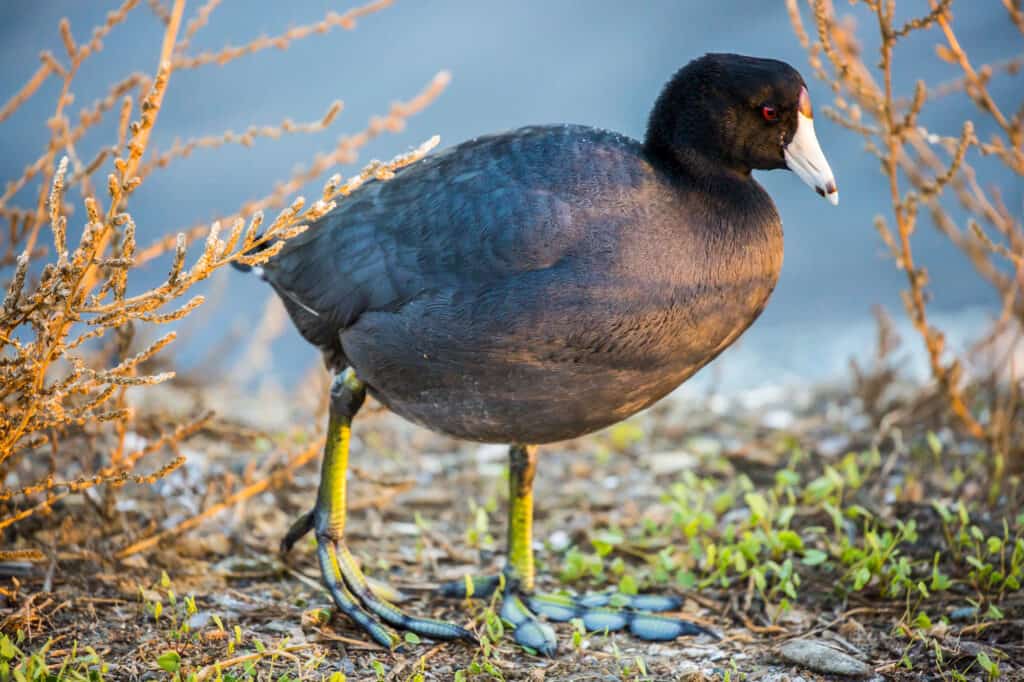
American coots live in wetlands throughout North America.
©yhelfman/Shutterstock.com
Identification: American coots are round and plump waterbirds, with short tails, short wings, and large feet. Adults are dark gray to black with white bills.
Habitat and Location: You will find them in ponds, marshes, reservoirs, and marshes throughout the United States, Mexico, and Canada.
Diet: Aquatic plants, insects, crustaceans, and snails are their top food choices.
Nests: They build unique floating shallow baskets.
Summary of 26 Black and White Birds (With Pictures of Each!)
| Bird | |
|---|---|
| 1 | Common Loon |
| 2 | Black-Capped Chickadee |
| 3 | Black and White Warbler |
| 4 | Carolina Chickadee |
| 5 | Lark Bunting |
| 6 | Black Phoebe |
| 7 | Blackpoll Warbler |
| 8 | Black-Billed Magpie |
| 9 | Rose-Breasted Grosbeak |
| 10 | American Oystercatcher |
| 11 | Black-Necked Stilt |
| 12 | White Wagtail |
| 13 | Pied Avocet |
| 14 | Black-Headed Ibis |
| 15 | Australian Magpie |
| 16 | Yellow-Bellied Sapsucker |
| 17 | Bufflehead |
| 18 | Razorbill |
| 19 | Downy Woodpecker |
| 20 | Hairy Woodpecker |
| 21 | White-Breasted Nuthatch |
| 22 | Penguins |
| 23 | Black-Crowned Night Heron |
| 24 | Black and White Hawk Eagle |
| 25 | Gyrfalcon |
| 26 | American Coot |
What Does Seeing a Magpie Mean?

Magpies represent luck and good fortune.
©iStock.com/JMrocek
Through the ages, bird sightings have been coupled with symbolism. The sighting of a magpie comes with certain superstition pertaining to luck. If 1 is spotted, it means the seer will have bad luck. The sighting of 2 magpies, however, means the seer will have good luck. Some disagree with this and see a sighting of a solitary bird as an omen of good luck. Some believe a sighting of 8 magpies represents delay, while a sighting of 9 promises new love, a new child, a special occasion, new passion, or future marital bliss. These highly intelligent birds are associated with adaptability, resourcefulness, communication, mischief, luck, and optimism. A chatterbox by nature, the magpie can be a gentle reminder to watch one’s words carefully, to find balance between idle chatter and important self expression.
The photo featured at the top of this post is © FotoRequest/Shutterstock.com
Thank you for reading! Have some feedback for us? Contact the AZ Animals editorial team.






